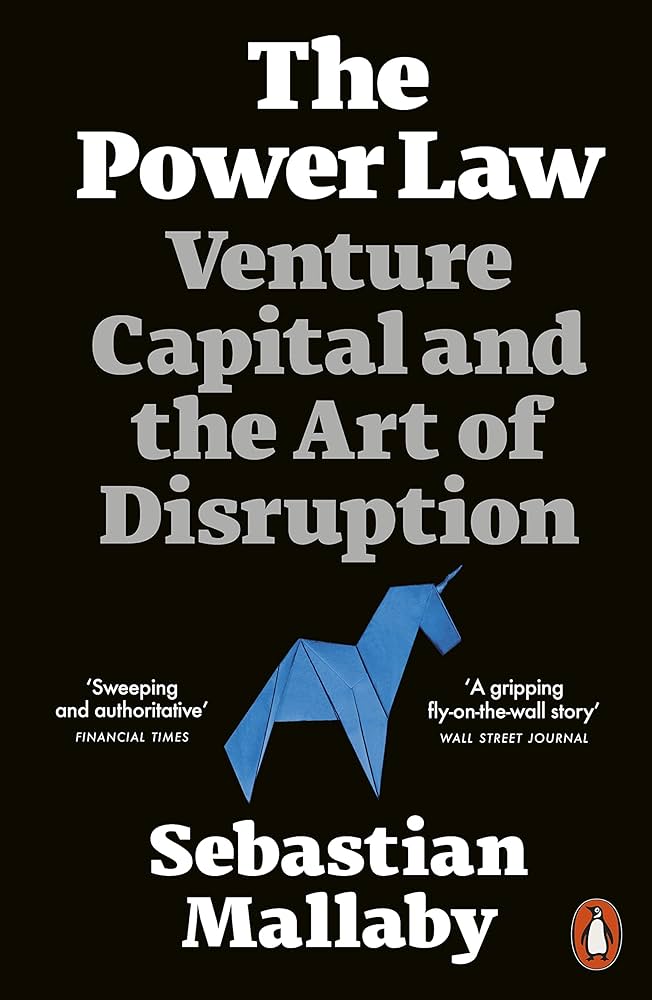
In the UK at least, the public image of the private equity industry is not good: those involved in it are widely regarded as a secretive, avaricious, immoral plutocracy that needs to be reined in. One may, however, wonder how many people know enough about the industry to be able to assess it properly, and how many realise that the technological revolution of the past 50 years would not have happened without the capital provided by venture capitalists to thousands of companies, including household names such as Intel, Apple, Cisco, Amazon, Google and Facebook. Even fewer people have any idea about the way in which the venture capital houses do business.
The Power Law sets out to remedy this ignorance. Sebastian Mallaby says that the book has two broad purposes: first, “to explain the venture-capital mindset” and, secondly, “to evaluate venture capital’s social impact” (page 14). However, its biggest strength is that it will ensure that its readers are better informed. It provides a sweeping overview of the fascinating history of venture capital from the early days of the 1950s to today and it gives the reader a good feel of the culture of the industry by drawing out common themes as well as stressing the differences in the approaches of the various venture capital houses and changes over time.
Sebastian Mallaby is a journalist and it shows. The Power Law is very readable and includes many stories and a considerable amount of direct speech. This may annoy some readers and obviously raises a question regarding the reliability of what is stated. For example, it must be doubtful whether those involved in the meeting between Don Valentine of Sequoia and Steve Jobs and Steve Wozniak of Apple in 1976 can really accurately remember precisely what was said but this has not prevented Mallaby setting out nearly half a page of quotations as if from a recording of the conversation (page 83f). There is also clearly a risk that the account of the meeting and other incidents related by Mallaby contain exaggerations brought about by people’s memories filtering the ordinary and over-emphasising the extraordinary. There may even be mythology creeping in. However, Mallaby says that he conducted “some 300 interviews” (page 405) as well as using written sources and this should at least mitigate the risk of distortion.
The book adopts a chronological approach and focuses on the people and organisations involved. Among the venture capitalists, it focuses on people like Arthur Rock (who more or less invented the industry), Don Valentine (of Sequoia, the most successful venture capital house over a long period of time) and Tom Perkins (of Kleiner Perkins Caufield & Byers). Among the founder entrepreneurs, it focuses both on household names like Steve Jobs and Mark Zuckerberg and others who may now be fading from memory such as Leonard Bosack and Sandy Lerner (the founders of Cisco). Mallaby does not seek to explain legal technicalities of the industry but he gives sufficient information to enable the non-specialist to appreciate the significance of developments such as the advent of equity-only time-limited funds, the use of limited liability partnerships and the grant of stock to employees.
The picture of venture capitalists that emerges is very different from their popular image. Of course, their aim is to make money but Mallaby is at pains to disprove the view that they make it by luck or simply by turning up like a predator when they sniff it. Their common characteristic is a willingness to take what many would regard as absurd risks. As Mallaby puts it, they acknowledge “the logic of the power law” (page 47). Put simply, venture capitalists see their downside as limited (they can only lose the money they put into a venture) but the upside as unlimited in a world in which “success multiplies success” (page 7) and thus “The best way to manage risk [is] to embrace it fearlessly” (page 47).
Subscribe to our Substack to receive new reviews and blogs by email
Uninformed public comment often seems to assume that venture capitalists are involved in win-win situations but Mallaby provides a wealth of evidence to the contrary including the fact that Kleiner Perkins lost money on six of the fourteen investments in its first fund, with Tandem and Genentec providing 95% of the profit in that fund (page 79), and “counting venture funds raised between 1979 and 2018, the median fund narrowly underperformed the stock market index” (page 376).
Mallaby draws attention to various things that will surprise many. In particular, the role of venture capitalists has been “to provide not simply money but also managerial counsel, assistance with hiring, and tips on everything from marketing to finance” (page 29). Furthermore, the culture within some of the most successful houses (notably Sequoia) has been remarkably team based and supportive rather than individualistic and aggressive and this spirit of co-operation has even extended to co-operation with competitors, “coopetition” as Mallaby calls it (page 107). Indeed, it could be argued that the existence of a community of venture capitalists has been key to the success of the industry.
The book also stresses the differences in the style of different houses: some (like Accel) focussing on a single industry and some on multiple industries; some (like Peter Thiel’s Founders Fund) not believing in the mentoring of founders but others regarding this as a key element of the necessary package; some (Arthur Rock’s Davis & Rock being the prime example) requiring a high degree of control but others being prepared to back the founders almost no matter what.
Mallaby’s portrait of the founder entrepreneurs has an element of the tabloid press about it and it will reinforce the popular image of them as a bunch of irredeemable oddballs. Mallaby makes sure that Arthur Rock’s comment about Steve Jobs’s hygiene is not forgotten (“I’m not sure, but it may have been some while since he had a bath”, page 86) and most readers will be entertained by the story of Mark Zuckerberg and Andrew McCollum turning up at the Sequoia headquarters late and in their pyjamas (page 194). After learning this, the reader may well be inclined to agree with the view of Peter Thiel that the best start-up founders are “often arrogant, misanthropic, or borderline crazy” (page 211).
The book provides an excellent analysis of the balance of power between the venture capital houses and the founder entrepreneurs. Those who see venture capitalists as ruthless puppet-masters may be surprised by this. For many years, the balance lay with the venture capitalists and there are well-known examples of them flexing their muscles (notably in the sacking of Lerner from Cisco following a venture capital “coup” led by Sequoia). However, Mallaby charts the changing balance of power over time including what he terms the “youth revolt” (i.e. the attitudes of a new generation of founders 20 or so years ago) facilitated by the considerable amount of capital then available in the market and the willingness of some investors to yield total control to the founders.
How should we evaluate the venture capital industry’s contribution to society? Mallaby turns to this question in the final chapter of his book and his conclusion is, rightly, overwhelmingly positive: “venture capitalists as a group have a positive effect on economies and societies” (page 379). Unfortunately, however, his analysis of the key issues is brief (occupying less than 13 pages) and, whilst much of what he says is powerful and he may legitimately point to the rest of the book as further evidence in support of his conclusion it would have been good to see a more in-depth analysis. Many people consider the rewards both for the venture capitalists and the founder entrepreneurs to be obscene and consider there to be a lack of accountability and a need for regulation, evidenced by some of the spectacular failures of venture capital backed companies (including the notorious Theranos scandal, the failure of WeWork and the governance and cultural issues at Uber).
The issue of rewards needs to be addressed head-on. They are, in part, an unalterable feature of the modern global economy and “the power law” and, unless those involved are to be severely taxed (which would remove the incentive to take risk), the high level of reward will remain. More fundamentally, the important issue is not how great the rewards are but what the impact on society of the actions of the venture capitalists and founder entrepreneurs is. Put simply, should we care that Steve Jobs and his venture capital backers became very rich? Surely not: they revolutionised communications for billions of people around the world and the impact of this has been overwhelmingly positive.
The demand for regulation is also misplaced. What exactly needs to be regulated? As Mallaby rightly points out (page 380), it is necessary to distinguish between the possible need to regulate the businesses in which venture capitalists invest and the question whether the venture capital businesses themselves need more regulation. The case for regulation of the latter is weak. Any attempt to regulate their investment decisions would either involve some kind of substitution of a regulator’s judgement of risk for that of the venture capitalists or be little more than the imposition of bureaucratic requirements. It is hard to see that either approach would have societal benefits.
The scandals, governance failures and bankruptcy of companies in which venture capitalists have invested do not in any way alter this point. In some cases, the venture capitalists were doing the right thing not the wrong thing. For example, the venture capital houses of Silicon Valley refused to invest in Theranos and it was venture capitalists who forced management change at Uber. We should also not forget that the technology revolution has required, and continues to require, that great financial risks be run by investors and some of the risks will materialise. The failure of a company does not demonstrate a flaw in the underlying economic system. Indeed, it frequently reflects the vibrancy of that system.
Of course, the venture capital industry has had its problems but so do all human institutions. The bottom line is that, to quote Mallaby, “Business schools and finance faculties have conclusively shown that VC-backed companies have a disproportionate impact on wealth creation and innovation” (page 389). This is for the benefit of the whole of society.
Mallaby has done well in presenting the positive story of the venture capital industry in an engaging and accessible manner. The Power Law deserves to be widely read.
“The Power Law: Venture Capital and the Art of Disruption” by Sebastian Mallaby was published in 2022 by Allen and in 2023 in Penguin Books (ISBN-13:9780141988948). 404pp.
 Richard Godden is a Lawyer and has been a Partner with Linklaters for over 30 years during which time he has advised on a wide range of transactions and issues in various parts of the world.
Richard Godden is a Lawyer and has been a Partner with Linklaters for over 30 years during which time he has advised on a wide range of transactions and issues in various parts of the world.
Richard’s experience includes his time as Secretary at the UK Takeover Panel and he is currently a member of the Panel. He also served as Global Head of Client Sectors, responsible for Linklaters’ industry sector groups, and was a member of the firm’s Executive Committee.